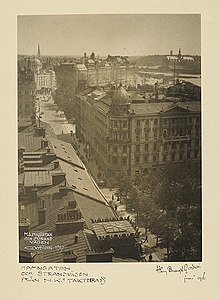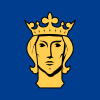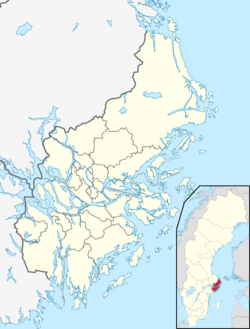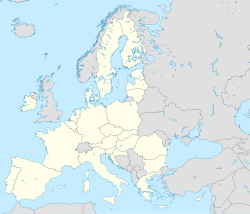
A | B | C | D | E | F | G | H | CH | I | J | K | L | M | N | O | P | Q | R | S | T | U | V | W | X | Y | Z | 0 | 1 | 2 | 3 | 4 | 5 | 6 | 7 | 8 | 9
Stockholm | |
|---|---|
|
| |
| Nickname(s): Sthlm, Eken, the Venice of the North, the Venice of Scandinavia[1] | |
| Coordinates: 59°19′46″N 18°4′7″E / 59.32944°N 18.06861°E | |
| Country | |
| Province | Södermanland and Uppland |
| County | Stockholm County |
| First mention | 1252 |
| Charter | 13th century |
| Government | |
| • Mayor | Karin Wanngård (S) |
| Area | |
| • Capital city | 188 km2 (73 sq mi) |
| • Urban | 381.63 km2 (147.35 sq mi) |
| • Metro | 6,519 km2 (2,517 sq mi) |
| Elevation | 28 m (92 ft) |
| Population | |
| • Capital city | 984,748 |
| • Density | 5,200/km2 (14,000/sq mi) |
| • Urban | 1,617,407 |
| • Urban density | 4,200/km2 (11,000/sq mi) |
| • Metro | 2,415,139 |
| • Metro density | 370/km2 (960/sq mi) |
| Demonyms |
|
| GDP | |
| • Metro | €153.963 billion (2020) |
| Time zone | UTC+1 (CET) |
| • Summer (DST) | UTC+2 (CEST) |
| Postal code | 100 00-199 99 |
| Area code | +46-8 |
| Website | start |
Stockholm (Swedish: [ˈstɔ̂kː(h)ɔlm] ⓘ)[10] is the capital and most populous city of Sweden as well as the largest urban area in the Nordic countries. Approximately 1 million people live in the municipality,[11] with 1.6 million in the urban area, and 2.4 million in the metropolitan area.[11] The city stretches across fourteen islands where Lake Mälaren flows into the Baltic Sea. Outside the city to the east, and along the coast, is the island chain of the Stockholm archipelago. The area has been settled since the Stone Age, in the 6th millennium BC, and was founded as a city in 1252 by Swedish statesman Birger Jarl. The city serves as the county seat of Stockholm County.
Stockholm is the cultural, media, political, and economic centre of Sweden. The Stockholm region alone accounts for over a third of the country's GDP,[12] and is among the top 10 regions in Europe by GDP per capita.[13] Considered a global city,[14] it is the largest in Scandinavia and the main centre for corporate headquarters in the Nordic region.[15] The city is home to some of Europe's top ranking universities, such as the Karolinska Institute, Stockholm School of Economics, KTH Royal Institute of Technology and Stockholm University.[16] It hosts the annual Nobel Prize ceremonies and banquet at the Stockholm Concert Hall and Stockholm City Hall. One of the city's most prized museums, the Vasa Museum, is the most visited museum in Scandinavia.[17] The Stockholm metro, opened in 1950, is well known for the decor of its stations; it has been called the longest art gallery in the world.[18] The city was the host of the 1912 Summer Olympics, and has played host to several other international sports events since.[19]
Stockholm is Sweden's primary financial centre, one of the largest in Scandinavia, and hosts several of Sweden's largest companies. Furthermore, the headquarters of most of Sweden's largest banks are in Stockholm. Stockholm is one of Europe's major tech centres; the city has sometimes been called Europe's innovation hub.[20] The Stockholm region has a GDP of around $180 billion,[21] and Stockholm County has the highest GDP per capita of all counties in Sweden.[22]
Stockholm is the seat of the Swedish government and most of its agencies,[23] including the highest courts in the judiciary,[24] and the official residences of the Swedish monarch and the Prime Minister. The government has its seat in the Rosenbad building, the Riksdag (Swedish parliament) is seated in the Parliament House,[25] and the Prime Minister's residence is adjacent at the Sager House.[26] Stockholm Palace is the official residence and principal workplace of the Swedish monarch, while Drottningholm Palace in neighbouring Ekerö serves as the Royal Family's private residence.[27]
History




After the Ice Age, around 8000 BCE, there were already many people living in what is today the Stockholm area, but as temperatures dropped, inhabitants moved south. Thousands of years later, as the ground thawed, the climate became tolerable and the lands became fertile, people began to migrate back to the North. At the intersection of the Baltic Sea and lake Mälaren is an archipelago site where the old town of Stockholm was first built from about 1000 CE by Vikings. They had a positive trade impact on the area because of the trade routes they created.
Stockholm's location appears in Norse sagas as Agnafit, and in Heimskringla in connection with the legendary king Agne. Birka, located near Stockholm, was one Sweden's major trade centres during the Viking Age, and its restored remains are one of Stockholm County's most-visited sites.[28]
The earliest written mention of the name Stockholm dates from 1252, by which time the mines in Bergslagen made it an important site in the iron trade. The first part of the name (stock) means log in Swedish, although it may also be connected to an old German word (Stock) meaning fortification. The second part of the name (holm) means islet and is thought to refer to the islet Helgeandsholmen in central Stockholm. According to the Eric Chronicles the city is said to have been founded by Birger Jarl to protect Sweden from sea invasions made by Karelians after the pillage of Sigtuna on Lake Mälaren in the summer of 1187.[29]
Stockholm's core, the present Old Town (Gamla Stan) was built on the central island next to Helgeandsholmen from the mid-13th century onward. The city originally rose to prominence as a result of the Baltic trade of the Hanseatic League. Stockholm developed strong economic and cultural linkages with Lübeck, Hamburg, Gdańsk (Danzig), Visby, Tallinn (Reval), and Riga during this time.[30] Between 1296 and 1478 Stockholm's City Council was made up of 24 members, half of whom were selected from the town's German-speaking burghers, reflecting the importance of Germans in medieval Nordic trade.
The strategic and economic importance of the city made Stockholm an important factor in relations between the Danish Kings of the Kalmar Union and the Swedish national independence movement in the fifteenth century and early sixteenth century. The Danish King Christian II was able to enter the city in 1520 and on 8 November of that year, a massacre of opposition figures called the Stockholm Bloodbath took place and set off further uprisings that eventually led to the breakup of the Kalmar Union with the attainment of Swedish independence. With the accession of Gustav Vasa in 1523 and the establishment of royal power, the population of Stockholm began to grow, reaching 10,000 by 1600.[31]
The seventeenth century saw Sweden grow into a major European power, reflected in the development of the city of Stockholm. From 1610 to 1680 the population multiplied sixfold. In 1634, Stockholm became the official capital of the Swedish empire. Trading rules were also created that gave Stockholm an essential monopoly over trade between foreign merchants and other Swedish, Baltic and Scandinavian territories. In 1697, Tre Kronor Castle burned down and was replaced eventually by Stockholm Palace; the time of the Swedish Empire also saw several architectural modernisations of the city.[32]
The beginning of the Swedish Empire saw a renaissance in the arts and sciences; the new queen, Christina, was a strong supporter of science and culture. Réne Descartes, one of the most prominent European philosophers of his time, died in Stockholm; he had been hosted by the queen for several years prior to his death. Inventors, like Christopher Polhem, moved to the city during the time of the Swedish Empire. Academics also spent much time in Stockholm, like Olaus Rudbeck, rector of the Uppsala University.[33]
Throughout Sweden's history, walls were created in Stockholm to defend the city from attacks. These defensive walls were modified throughout the 13th to the 16th century. In 1625, the Great Stockholm Fire of 1625 destroyed the southwestern section of Stadsholmen, an island in the centre of Stockholm.[34] The amount of destruction led to the beginning of the demolition of the Stockholm walls. Today, most of the younger city walls cannot be found anywhere above ground. However, parts of the northern city walls are preserved in the modern Museum of Medieval Stockholm.[35]
In 1710, a plague killed about 20,000 (36 percent) of the population.[36] After the end of the Great Northern War the city stagnated; population growth halted and economic growth slowed. The city was in shock after having lost its place as the capital of a great power. However, Stockholm maintained its role as Sweden's political centre and continued to develop as the country's economic and cultural capital.[37]
During the Age of Enlightenment in the late eighteenth century, the city flourished. The new monarch, Gustav III, proved an able and energetic regnant; his economic policies helped the Swedish economy develop, and his partially successful war against Russia restored some of Sweden's international reputation. The king was an avid patron of the arts, and scientists and cultural figures flocked to Stockholm on a scale unprecedented since the reign of Queen Christina.[38]
During this time, Carl Michael Bellman and Joseph Martin Kraus helped develop the city's music, a process further accelerated by the founding of the Royal Swedish Opera.[39] Various artists and writers became prominent, funded by the king and other cultural patrons like Carl Gustaf Tessin; the two aforementioned figures laid the base for Sweden's Nationalmuseum at this time. Science also became prevalent; renowned figures like Carl Linnaeus and Anders Celsius spent time in Stockholm, and various research institutes, like the Stockholm Observatory, were founded.[40]
The early nineteenth century saw a major economic decline of Stockholm and Sweden as a whole, but by the second half of the nineteenth century, Stockholm had regained its leading economic role. New industries emerged with industrialisation and Stockholm was transformed into an important trade and service centre as well as a key gateway point within Sweden. The population also grew dramatically during this time, mainly through immigration. At the end of the nineteenth century, less than 40% of the residents were Stockholm-born, with most migrants being from poorer rural Sweden; major settlement began to expand outside the historical city limits. The nineteenth century also saw the establishment of a number of scientific institutes and universities, including the Karolinska Institutet and KTH Royal Institute of Technology. The General Art and Industrial Exposition was held in 1897,[41] drawing international attention. From 1887 to 1953 the Old Stockholm telephone tower was a landmark; originally built to link phone lines, it became redundant after these were buried, and it was later used for advertising before its demolition in the twentieth century. The early twentieth century also saw the creation of the Nobel Prizes, some of Stockholm's most renowned institutions.[42]
Stockholm became a modern and ethnically diverse city in the latter half of the 20th century. Many historical buildings were torn down during the modernist era, including substantial parts of the historical district of Klara (which caused major controversy), and replaced with modern architecture. However, in many other parts of Stockholm (such as in Gamla stan, Södermalm, Östermalm, Kungsholmen and Vasastan), many older buildings, blocks and streets built before the modernism and functionalism movements survived this era of demolition. Throughout the century, many industries shifted away from industrial activities into more high-tech and service industry areas, which still dominate the city's economy today.[20]
Stockholm's metropolitan area is one of the fastest-growing regions in Europe, and its population is expected to number 2.5 million by 2024.[needs update] In 2020 alone, Stockholm's population increased by 1,477.[43] As a result of this massive population growth, there has been a proposal to build densely packed high-rise buildings in the city centre connected by elevated walkways, though these have been opposed by several groups.[44]
Geography
Location

Stockholm is located on Sweden's east coast at the 59th parallel north,[45] where the freshwater Lake Mälaren—Sweden's third-largest lake—flows out into the Baltic Sea. The central parts of the city consist of fourteen islands that are continuous with the Stockholm archipelago. The geographical city centre is situated on the water, in Riddarfjärden bay. Over 30% of the city area is made up of waterways and another 30% is made up of parks and green spaces.
Positioned at the eastern end of the Central Swedish lowland and near the Bergslagen region, the city's location reflects the early orientation of Swedish trade toward the Baltic region.[46]
Stockholm belongs to the Temperate deciduous forest biome, which means the climate is very similar to that of the far northeastern area of the United States and coastal Nova Scotia in Canada. The average annual temperature is 7.9 °C (46 °F). The average rainfall is 531 mm (21 in) per year. The deciduous forest has four distinct seasons, spring, summer, autumn, and winter. In the autumn the leaves change color. During the winter months, the trees lose their leaves.
For details about the other municipalities in the Stockholm area, see the pertinent articles. North of Stockholm Municipality: Järfälla, Solna, Täby, Sollentuna, Lidingö, Upplands Väsby, Österåker, Sigtuna, Sundbyberg, Danderyd, Vallentuna, Ekerö, Upplands-Bro, Vaxholm, and Norrtälje. South of Stockholm: Huddinge, Nacka, Botkyrka, Haninge, Tyresö, Värmdö, Södertälje, Salem, Nykvarn and Nynäshamn.
Stockholm Municipality
Stockholm Municipality is an administrative unit defined by geographical borders. The semi-official name for the municipality is City of Stockholm (Stockholms stad in Swedish).[47] As a municipality, the City of Stockholm is subdivided into district councils, which carry responsibility for primary schools, social, leisure and cultural services within their respective areas. The municipality is usually described in terms of its three main parts: Innerstaden (Stockholm City Centre), Söderort (Southern Stockholm) and Västerort (Western Stockholm). The districts of these parts are:
Stockholm City Centre
Söderort
Västerort
The modern centre Norrmalm (concentrated around the town square Sergels torg) is the largest shopping district in Sweden.[48] It is the most central part of Stockholm in business and shopping.
Climate
Stockholm has a humid continental climate in the 0 °C isotherm (Köppen: Dfb)[49][50] bordering on an oceanic climate (Cfb) in the -3 °C isotherm. Although winters are cold, average temperatures generally remain above 0 °C for much of the year. Summers are pleasantly warm, and precipitation occurs throughout the year.[51]
Due to the city's high northerly latitude, the length of the day varies widely from more than 18 hours around midsummer to only around 6 hours in late December. The nights from late May until mid-July are not completely dark even when cloudy. Stockholm has relatively mild weather compared to other locations at a similar latitude, or even farther south. With an average of 1900 hours of sunshine per year, it is also one of the sunniest cities in Northern Europe, receiving more sunshine than Paris, London and a few other major European cities of a more southerly latitude. Because of the urban heat island effect and the prevailing wind travelling overland rather than sea during summer months, Stockholm has the warmest July months of the Nordic capitals. Stockholm has an annual average snow cover between 75 and 100 days.[52]
Despite its mild climate, Stockholm is located further north than parts of Canada that are above the Arctic tree line at sea level.[53]
Summers average daytime high temperatures of 20–25 °C (68–77 °F) and lows of around 13 °C (55 °F), but temperatures can reach 30 °C (86 °F) on some days. Days above 30 °C (86 °F) occur on average 1.55 days per year (1992–2011).[54] Days between 25 °C (77 °F) and 30 °C (86 °F) are relatively common especially in July and August. Night-time lows of above 20 °C (68 °F) are rare, and hot summer nights vary from 17 to 18 °C (63 to 64 °F). Winters generally bring cloudy weather with the most precipitation falling in December and January (as either rain or snow). The average winter temperatures range from −3 to −1 °C (27 to 30 °F), and occasionally drop below −20 °C (−4 °F) in the outskirts of the city. Spring and autumn are generally cool to mild.
The climate table below presents weather data from the years 1991–2020. According to ongoing measurements, the temperature has increased during the years 1991–2020 as compared with the last series, from 1961 to 1990. This increase averages about 1.0 °C (1.8 °F) over all months. Warming is most pronounced during the winter months, with an increase of more than 2.0 °C (3.6 °F) in January.[55] For the 2002–2014 measurements some further increases have been found, although some months such as June have been relatively flat.
The highest temperature ever recorded in Stockholm was 36 °C (97 °F) on 3 July 1811; the lowest was −32 °C (−26 °F) on 20 January 1814.[56] The temperature has not dropped to below −25.1 °C (−13.2 °F) since 10 January 1987.[57][58]
The warmest month ever recorded was July 2018 with a mean temperature of 22.5 °C (72.5 °F) which is also the nationwide record.
Annual precipitation is 546.4 mm (21.51 in) with around 170 wet days and light to moderate rainfall throughout the year. The precipitation is not uniformly distributed throughout the year. The second half of the year receives 50% more than the first half. Snowfall occurs mainly from December through March. Snowfall may occasionally occur in late October as well as in April.
In Stockholm, the aurora borealis can occasionally be observed.
| Climate data for Stockholm (Observatorielunden), 1991–2020 normals, extremes since 1901 | |||||||||||||
|---|---|---|---|---|---|---|---|---|---|---|---|---|---|
| Month | Jan | Feb | Mar | Apr | May | Jun | Jul | Aug | Sep | Oct | Nov | Dec | Year |
| Record high °C (°F) | 11.0 (51.8) |
12.2 (54.0) |
17.8 (64.0) |
26.1 (79.0) |
29.0 (84.2) |
32.2 (90.0) |
34.8 (94.6) |
35.4 (95.7) |
27.9 (82.2) |
20.2 (68.4) |
15.1 (59.2) |
12.7 (54.9) |
35.4 (95.7) |
| Mean maximum °C (°F) | 6.6 (43.9) |
7.1 (44.8) |
12.0 (53.6) |
18.8 (65.8) |
24.3 (75.7) |
27.5 (81.5) |
29.7 (85.5) |
28.2 (82.8) |
22.4 (72.3) |
15.8 (60.4) |
10.7 (51.3) |
8.5 (47.3) |
30.6 (87.1) |
| Mean daily maximum °C (°F) | 1.0 (33.8) |
1.2 (34.2) |
4.7 (40.5) |
10.7 (51.3) |
16.5 (61.7) |
20.8 (69.4) |
23.6 (74.5) |
22.1 (71.8) |
16.6 (61.9) |
10.1 (50.2) |
5.4 (41.7) |
2.5 (36.5) |
11.3 (52.3) |
| Daily mean °C (°F) | −1.0 (30.2) |
−1.0 (30.2) |
1.6 (34.9) |
6.3 (43.3) |
11.4 (52.5) |
15.7 (60.3) |
18.7 (65.7) |
17.7 (63.9) |
13.1 (55.6) |
7.7 (45.9) |
3.6 (38.5) |
0.6 (33.1) |
7.9 (46.2) |
| Mean daily minimum °C (°F) | −2.9 (26.8) |
−3.2 (26.2) |
−1.1 (30.0) |
2.6 (36.7) |
7.1 (44.8) |
11.6 (52.9) |
14.8 (58.6) |
14.2 (57.6) |
10.2 (50.4) |
5.5 (41.9) |
1.9 (35.4) |
−1.2 (29.8) |
5.0 (41.0) |
| Mean minimum °C (°F) | −11.2 (11.8) |
−10.9 (12.4) |
−7.5 (18.5) |
−2.6 (27.3) |
1.9 (35.4) |
7.0 (44.6) |
10.6 (51.1) |
9.7 (49.5) |
4.6 (40.3) |
−0.8 (30.6) |
−4.5 (23.9) |
−8.3 (17.1) |
−13.7 (7.3) |
| Record low °C (°F) | −28.2 (−18.8) |
−25.5 (−13.9) |
−22.0 (−7.6) |
−11.5 (11.3) |
−4.5 (23.9) |
1.0 (33.8) |
6.0 (42.8) |
4.8 (40.6) |
−1.5 (29.3) |
−9.0 (15.8) |
−17.0 (1.4) |
−21.0 (−5.8) |
−28.2 (−18.8) |
| Average precipitation mm (inches) | 37.0 (1.46) |
29.4 (1.16) |
27.3 (1.07) |
29.2 (1.15) |
34.0 (1.34) |
61.7 (2.43) |
61.5 (2.42) |
66.2 (2.61) |
53.3 (2.10) |
51.4 (2.02) |
47.6 (1.87) |
47.8 (1.88) |
546.4 (21.51) |
| Average snowfall cm (inches) | 23.3 (9.2) |
25.6 (10.1) |
18.1 (7.1) |
5.9 (2.3) |
1.1 (0.4) |
0.0 (0.0) |
0.0 (0.0) |
0.0 (0.0) |
0.0 (0.0) |
1.8 (0.7) |
6.6 (2.6) |
20.3 (8.0) |
102.7 (40.4) |
| Mean monthly sunshine hours | 43.9 | 75.1 | 150.8 | 215.9 | 277.4 | 277.4 | 279.5 | 234.5 | 170.3 | 95.8 | 44.6 | Zdroj:https://en.wikipedia.org?pojem=Stockholm,_Sweden||












